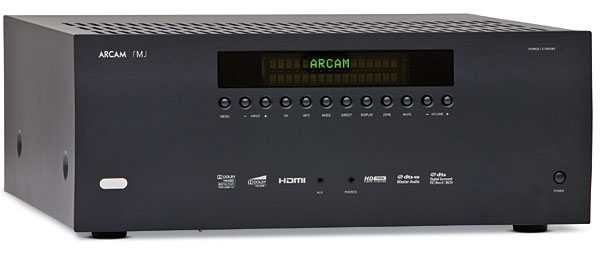Arcam AVR360 A/V Receiver Page 2
Devils and Demons
The audiophile virtues were present in abundance. This receiver covered the frequency spectrum from low to medium to high in admirable (and highly listenable) proportions. Classical proportions, you might even say. I never felt there was anything lacking in bass down to the 80Hz crossover I typically use with my speakers. Midrange—I can never mention it too many times—was warm, liquid, and well-balanced, without that fatal hyping of the presence region that often makes me uncomfortable. High frequencies were also balanced, neither rolled off nor exaggerated. When the receiver reached into its power reserves for a dynamic challenge, it usually behaved well, with the result that I rarely resorted to the use of Dolby Volume to tame extremes of dynamics.
 The Devil’s Double (Blu-ray, DTS-HD Master Audio) had an epic sweep, with Dominic Cooper playing both Saddam Hussein’s psychopathic son and his hapless body double. Confronted with complex, layered information—like a hushed orchestra waxing over bloody battle footage—the Arcam delivered the dramatic goods. Finding a master volume level that reconciled dialogue and effects was never a burden. I was able to make minimal decisions early on and stick with them throughout the movie.
The Devil’s Double (Blu-ray, DTS-HD Master Audio) had an epic sweep, with Dominic Cooper playing both Saddam Hussein’s psychopathic son and his hapless body double. Confronted with complex, layered information—like a hushed orchestra waxing over bloody battle footage—the Arcam delivered the dramatic goods. Finding a master volume level that reconciled dialogue and effects was never a burden. I was able to make minimal decisions early on and stick with them throughout the movie.
Night of the Demons (Blu-ray, DTS-HD Master Audio) is a New Orleans–based, haunted-house story with the usual abrupt shock effects. This was the only selection that benefited from a dash of Dolby Volume, with its dynamic range compression operating at the lowest setting. The contrast with the previous and following selections showed how the Arcam dealt with cruder source material. As a high-resolution product, it didn’t entirely whitewash the truth. But clean amplification can make even a cheesy horror soundtrack less abrasive.
The Depression-era circus epic Water for Elephants utterly seduced me when it flowed out of the Arcam/Paradigm system. My notebook filled with slightly ephemeral high-end superlatives like flow and pacing. The soundfield was big and well-defined, suiting a life lived in tents and outdoors, and an interlude of rainfall felt realistic. Music was sweet and satisfying, even from an old Bessie Smith 78. This combination of content and hardware reminded me why I became a toy critic in the first place. It was pleasurable and moving.
Strings Don’t Lie
Stringed instruments—whether in an orchestra or chamber group—can quickly reveal the strengths and weaknesses of a system. To my ears, they’re as revealing as voices. The Arcam acted like a true music lover’s receiver with the Emerson String Quartet’s Sony Classical CD of Mozart’s Prussian Quartets. At the behest of the Prussian king, Mozart gave special attention to the cello parts, and the Arcam responded with a loving treatment of the instrument’s wooden body, loaded with almost holographically imaged resonance and beauty. There was detail but no overzealous etching. The instrument emerged as a full-bodied whole. It sang.
The Dave Brubeck Quartet’s Jazz Impressions of New York (on LP) has a typical 1960s mix with the leader’s piano at far right, Joe Morello’s swinging drums at far left, and Paul Desmond’s suave voice-like sax hovering in the middle along with the bass. The Arcam adeptly imaged the alto sax, revealing (but not hyping) the voice-like breathiness that humanized Desmond’s playing. It had no trouble getting rhythmic urgency out of the two percussion instruments.
The Beatles’ Revolver gets regular workouts in my procession of review systems, especially when I’m already in a good mood. I’m still playing the first-generation CD release. Even now, it’s still a revelation compared with the old, awful American vinyl. The Arcam did what a good amp always does for this album. Rather than tyrannically impose a uniform sound of its own, it emphasized the sonic individuality of each track, from the stinging lead guitar of “Taxman” to the pumping strings of “Eleanor Rigby” to the naturalistically miked acoustic guitars of “I’m Only Sleeping” to the complex, textured riot of “Tomorrow Never Knows.”

Though not cheap, the AVR360 sets a new standard of affordability for anyone hungering for the Arcam sound. If you want maximum features per buck, look elsewhere. If you want to power speakers with low sensitivity or efficiency ratings, the rail- switching AVR600 is a better bet. But with the right speakers, the AVR360 is just the ticket for the budget-minded audiophile seeking a receiver that celebrates musical and cinematic values.
[Editor’s Note: Prospective buyers should read four Video Test Bench report for the Arcam AVR360, which performed below our benchmarks for the deinterlacing of 1080i, film-based, 3:2 content in its conversion to 1080p output, and also clipped both below black and above white signals on HDMI with upscaling engaged. These flaws would not be visible on all content and would likely be missed by all but the most critical viewers. Video processing in the AVR360 can be set for passthrough, which bypasses the processing and allows the source or disply to perform the conversion while eliminating the clipping. Clipping is an error we see fairly frequently in AVRs, although often with less severity, but neither error should really appear in an $1,800 receiver, especially given today’s excellent third-party video processing solutions. The AVR360’s Top Pick designation is wholly based on the weight of its extraordinary audio performance, with the recognition that, for most users in practice, the video flaws would neither be obvious nor a dealbreaker. —Rob Sabin]
























































